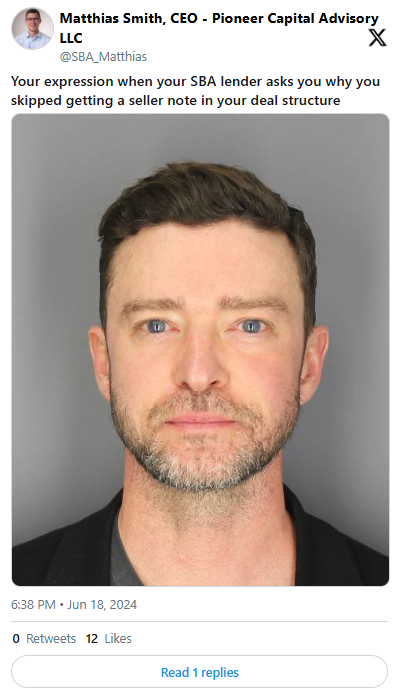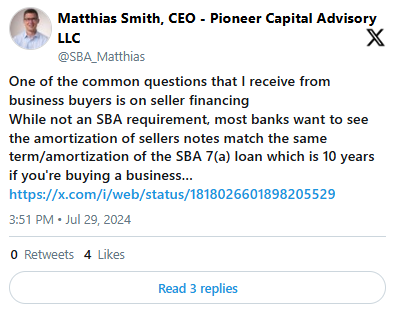


What SBA Lenders Want to See for Seller Note Requirements in Business Acquisitions
When you’re structuring an SBA 7(a) loan for a business acquisition, seller notes often play a pivotal role in bridging the gap between what the buyer can afford and the seller’s asking price.

However, to ensure that everything moves forward smoothly, it’s essential to understand what SBA lenders expect when seller financing is involved. Oftentimes, seller financing structures do not match the expectations of SBA lenders. In this blog post, I will show you how to structure your seller financing like a pro.
Primarily, I highly recommend making seller financing a part of your deal. Besides the benefits for buyers, there are notable benefits for sellers, including the ability to defer capital gains taxes.

Today, we’ll dive deep into the specifics of what SBA lenders require, how the Standby Creditor’s Agreement works, and why including seller financing might be a win-win for both buyers and sellers.
1. The Importance of the Seller Note in SBA 7(a) Loans
Seller notes are commonly used in SBA 7(a) loans, particularly for small to medium-sized business acquisitions. Essentially, the seller agrees to lend a portion of the purchase price to the buyer, making the deal more feasible for buyers who might not have enough upfront capital to cover the entire cost.
For the seller, it’s an opportunity to collect income for some time after the transaction. It can also help the seller defer taxes (more on this later).
But here's where to be cautious: SBA lenders are specific about how these seller notes should be structured.
At the core of these requirements is the fact that seller notes must be subordinated to the SBA loan. This means that in the event of a default, the SBA loan gets repaid first, and only after that is the seller entitled to repayment.
2. Understanding the Standby Creditor’s Agreement
To formalize the subordination of the seller note, the SBA requires the use of a Standby Creditor’s Agreement. This document acknowledges that if the seller decides to file a UCC-1 state filing to secure their lien position for the business acquisition financing that they are in junior lien position behind the SBA lending institution. Said another way, if the business buyer defaults on the SBA 7(a) loan and there is a liquidation scenario, the seller can’t pursue collateral ahead of the SBA lending institution.. If the seller is not agreeable with signing a Standby Creditor Agreement, the SBA lending institution will not be willing to approve the SBA loan.
This agreement also details other critical terms, including what happens if the seller receives payments in violation of the standby agreement. Specifically, the seller must hand over any such payments to the SBA lender within 15 days. The agreement protects the SBA’s interest and ensures that the seller’s claims don’t interfere with the borrower’s ability to meet SBA loan obligations.
3. Full Standby for the Entire Duration of the SBA Loan Term
As of June 1st, 2025, the SBA requires that if a business buyer wants to use a seller’s note towards the down payment for the SBA acquisition, the seller’s note needs to be on full standby for the entire duration of the SBA loan meaning that no payments can be made on it until after the SBA loan has been paid off in full. The current SBA guidelines stipulate that no more than half of the 10% equity injection (down payment) can come from a seller’s note on full standby. The other half must come from cash from either the buyer and/or investors (collectively). It should be noted that the 10% equity injection is based on the total project costs which includes the purchase price of the business plus working capital financed into the SBA loan plus due diligence costs (legal & financial) plus the bank closing costs plus the SBA guarantee fee. Oftentimes, buyers may be under the impression that the 10% equity injection is based on the purchase price of the business which is not the case.
Why?
The SBA wants to ensure that all available cash flow is directed toward repaying the SBA loan, especially in the critical early years when the business is adjusting to new ownership.
This requirement is formalized through the Standby Creditor’s Agreement, which lays out that the seller will accept no payments until the SBA loan is paid in full.
4. Partial Standby: The Old Option (No Longer Allowable)
If you're structuring a business acquisition using SBA 7(a) financing, it's critical to understand a key change that went into effect on June 1, 2025. Under the previous SBA guidelines, a seller note that was placed on full standby for the first two years and then repaid over the remaining term of the loan could be counted toward the required borrower equity injection. This is no longer permitted.
As of June 1, 2025, seller notes—even those on standby—may not be counted as part of the buyer’s down payment. If your deal relies on this outdated structure, your SBA lender or consultant will flag it, and you’ll likely need to restructure your financing. That can delay your timeline and create unnecessary friction between you and the seller.
To avoid headaches later, ensure your capital stack reflects this updated policy from the start.
5. Taking Action Against Borrower Collateral: Not Without Permission
Another key element of the Standby Creditor’s Agreement is that the seller is restricted from taking action against the borrower’s collateral while the SBA loan is still outstanding. This means the seller cannot seize business assets, like equipment or inventory, in the event of a default on the seller note unless they receive written permission from the SBA lender.
Why is this important? It ensures that the SBA lender maintains control over the borrower’s assets, which are often critical to securing repayment of the SBA loan. This protection is vital for the SBA’s ability to enforce repayment in case of default.
6. Best Practice: Aligning the Term of the Seller Note with the SBA Loan
A smart approach when structuring your deal is to align the term of the seller note with the SBA loan—or make it even longer. For example, if the SBA loan is set for 10 years, it's generally wise to mirror that with a 10-year seller note. This helps keep things smooth from a cash flow perspective and avoids having big seller payments due too early in the life of the business.
That said, some banks may be comfortable with a balloon payment on the seller note as early as year 4 or 5, as long as the business is cash flowing well by that point. But anything earlier is usually a red flag.
Also, if you're planning to go back to your SBA lender to refinance or pay off the seller note down the line, there's an important rule to keep in mind: the seller note must have been on regular monthly payments for at least two years after closing to qualify for refinancing. And here's a little-known trick—if you're trying to keep debt service coverage as light as possible while still keeping the note eligible for refinancing, you can structure the seller note with token payments (say, $1 per month). That way, you're technically making payments, but the impact on your cash flow is virtually zero.

7. Interest Rates on Seller Notes: Keeping It Reasonable
When structuring a seller note as part of an SBA-financed acquisition, it’s essential to approach the interest rate with both strategic care and a spirit of partnership. While the SBA does not impose a specific interest rate ceiling on seller financing, lenders will look closely to ensure that the agreed-upon rate is reasonable and sustainable—especially in the early stages of ownership transition when cash flow is critical.
In most transactions, seller note interest rates typically fall within the range of 5% to 8%. However, this range isn’t set in stone. The ideal rate should reflect the unique contours of the deal, including the risk profile, deal size, industry norms, and buyer–seller dynamics. The goal is to strike a balance—offering the seller a fair return for deferring part of the purchase price, while not overburdening the buyer or the business itself during its critical post-close phase.
If a standby agreement is involved—especially a partial standby where the seller is permitted to receive interest-only payments during the SBA loan’s first two years—the rate must be formally documented in the Standby Creditor’s Agreement. This document outlines the terms under which the seller may receive interest before any principal payments are made, and it plays a vital role in lender underwriting.
A thoughtfully structured, clearly documented, and market-aligned seller note interest rate supports a smooth transition, reduces lender friction, and ultimately fosters trust among all parties. The emphasis should always be on what is fair, feasible, and in service of long-term success.
8. Seller Financing’s Tax Benefits: Deferring Capital Gains Taxes
One lesser-known advantage of offering seller financing in a business sale is the potential to delay paying capital gains taxes. When a seller agrees to receive payments over time—rather than a full lump sum at closing—they may qualify to report the gain gradually through what the IRS refers to as the Installment Sale Method. This approach can help sellers smooth out their tax liabilities by spreading them across multiple tax years.
It’s important to note that whether this method applies depends on how the deal is structured (e.g., asset purchase versus stock purchase) and the relevant federal and state tax laws. Sellers should always consult a qualified tax professional to determine if this strategy is suitable for their specific transaction.
As outlined in IRS Publication 537, using the Installment Sale Method allows sellers to recognize capital gains only as they receive principal payments. This may keep them in a lower tax bracket year-to-year, making seller financing not just a deal sweetener, but also a smart tax planning tool. By deferring taxes, sellers can manage their financial exposure more efficiently while increasing the appeal of their deal to buyers reliant on SBA loan structures.
9. Why the Debt Service Coverage Ratio (DSCR) Matters and How Seller Notes Can Help
When it comes to getting an SBA loan to buy a business, one of the most important financial metrics lenders look at is the Debt Service Coverage Ratio, or DSCR. This ratio tells the lender whether the business will generate enough cash flow to cover its debt payments after the acquisition. In simple terms, it answers the question: Can this business afford its loans based on the income it brings in?
If the DSCR falls below a certain threshold—typically 1.15x or 1.25x depending on the lender—the loan may not get approved. Even if it does, a low DSCR can signal financial strain and increase the risk of default in the eyes of the lender. That’s why the way a deal is structured, especially when it comes to seller financing, can have a big impact on this key ratio.
This is where something called a Standby Creditor’s Agreement comes into play. When a seller agrees to finance part of the purchase price through a seller note, the SBA usually wants to make sure that the buyer isn’t burdened with too many payments all at once. So, to ease that concern, the lender might require the seller to sign this agreement, which essentially says the seller will wait to be paid.
Instead of making monthly payments on the seller note right away, the buyer can pause those payments for a period of time, often until the SBA loan is partially or fully paid down. During this standby period, the seller note still exists as a debt, but it’s not putting pressure on the company’s cash flow. This setup makes a huge difference when calculating the DSCR because the standby note payments don’t count against the business’s available income in the eyes of the SBA lender.
In practical terms, this structure gives the new owner some breathing room. Running a business right after an acquisition can be unpredictable. Revenues may fluctuate, and it might take time to stabilize operations under new ownership. By deferring seller note payments, the business has more flexibility to manage its SBA loan obligations without being stretched too thin.
So, while it might seem like a small legal detail, a Standby Creditor’s Agreement can be a powerful tool in helping the deal go through. It gives the buyer a better shot at securing financing, keeps the DSCR healthy, and sets the business up for smoother cash flow management during those critical early months and years of ownership.
10. Seller Notes Can Count Toward Buyer’s Equity
Seller notes may count toward the buyer’s required equity injection only if they are on full standby for the entire duration of the SBA 7(a) loan. This requirement is effective as of June 1st, 2025 when the SBA guidelines most recently changed. Obtaining a full standby seller’s note as part of your capital stack as a business buyer helps you to de-risk your acquisition because the seller has capital at risk if the transition of the business does not go smoothly following closing. Further, it shows the SBA lending institution that the seller is financially aligned with making the transition go smoothly for you as the buyer.
Ultimately, the terms and conditions of the full standby seller’s note will be memorialized in the SBA Standby Creditor Agreement (SBA Form 155) which will be completed by the legal counsel of the SBA lending institution. The best practice that Pioneer Capital Advisory recommends to business buyers is to include a draft of the SBA Form 155 as a specimen or exhibit to the LOI at the time you present your offer to the seller so that the first time the seller sees this document is not shortly ahead of closing.
11. Documentation is Everything
When it comes to seller notes in SBA deals, documentation is key. Every detail of the seller note—its subordination, standby provisions, interest rates, and repayment schedule—must be clearly outlined in the Standby Creditor’s Agreement. Without this, the SBA lender will not approve the loan, and the deal could collapse.
Ensure everything is thoroughly documented to avoid any delays or complications during the loan approval process.
Wrapping It Up: Seller Notes, Standby Agreements, and Tax Benefits
Seller notes are a valuable tool in SBA-financed business acquisitions, but they need to be structured carefully to meet SBA guidelines. The Standby Creditor’s Agreement plays a vital role in protecting the SBA’s interest and ensuring that the business can focus on repaying the loan.
And for sellers, there’s a major bonus—deferring capital gains taxes through seller financing can make the deal even more appealing.
Whether you’re a buyer or seller, understanding how to structure the seller note correctly is crucial. By working closely with your lender, accountant, and legal counsel, you can ensure that the deal goes smoothly and benefits all parties involved.
About Pioneer Capital Advisory LLC
Pioneer Capital Advisory LLC is a boutique commercial loan brokerage firm that helps buyers of small to medium-sized businesses navigate the SBA 7(a) financing process. Our firm has successfully closed deals for buyers across a wide range of industries, including HVAC, background check companies, landscaping, and much more. Importantly, we are paid by the SBA lender banks after closing, not by the buyer directly, making our services both valuable and cost-effective for buyers. Our team includes two decades of SBA lending expertise and has a deep bench of both operational expertise coupled with a robust bench of underwriting professionals. We are here to help with ensuring that your SBA acquisition is structured in a way that is compliant, pragmatic and prudent.
Disclaimer: The information in this newsletter is for informational purposes only and should not be considered legal or financial advice. Business buyers are encouraged to consult with their legal counsel and accountant to ensure the proper structuring of their transactions and to fully understand the tax implications of seller financing.
Thanks for reading! If you have any questions or thoughts, feel free to get in touch with us directly.
New Blog Posts

